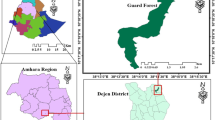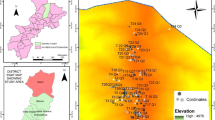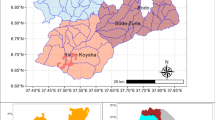Abstract
The epiphytic vegetation on 24 pollarded trees of Fraxinus excelsior at the farm Grinde, Leikanger, western Norway was investigated. Each trunk was divided into a basal zone, a middle zone and a top zone. In each zone the four different aspects were analysed (12 sampling units from each trunk). Within a total of 276 sampling units, 162 taxa were recorded (99 lichens, 56 bryophytes, 7 vascular plants). The trunks were covered mainly by an old, thick and occasionally swollen bark, but decaying wood did not occur. Their habitats were different, and each trunk was classified into one of four categories: open meadow, wooded hay meadow, deciduous wood, and spruce plantation. A climate station was established in each habitat to measure important parameters. The floristic and environmental data were analysed by canonical correspondence analysis (CCA). The floristic data were classified into eight TWINSPAN groups that have been taken into account in the CCA diagrams. At Grinde all the pollarded trunks grew under fairly homogeneous conditions during a more extensive agricultural period until about 1962. The deciduous wood developed by tree colonization on old meadows and wooded hay meadows, whilst spruce has been planted in a small part of the area. Floristic differences in the epiphytic vegetation between the four different habitats were found, which suggests that changes in the vegetation have developed during the last two or three decades. The spruce plantation was the most shady habitat having a very sparse epiphytic vegetation, mainly remnants from vegetation established during more open area conditions.
Similar content being viewed by others
References
Adams, D. B. & Risser, P. G. 1971. Some factors influencing the frequency of bark lichens in north central Oklahoma. Am. J. Bot. 58: 752–757.
Andersson, L. & Johansson, K. A. 1984. Epifyter påhamlade askar i Ölmestorp. Skaraborgsnatur 21: 156–159.
Austad, I. 1988. Tree pollarding in Western Norway. Pp. 11–29. In: Birks, H. H., Birks, H. J. B., Kaland, P. E. & Moe, D. (eds), The cultural landscape, past, present and future. Cambridge University Press.
Austad, I. & Losvik, M. H. 1998. Changes in species composition following field and tree layer restoration and management in a wooded hay meadow. Nord. J. Bot. 18: 641–662.
Austad, I. & Skogen, A. 1990. Restoration of a deciduous woodland in Western Norway formerly used for fodder production: effects on tree canopy and field layer. Vegetatio 88: 1–20.
Barkman, J. J. 1958. Phytosociology and ecology of cryptogamic epiphytes. Assen, Netherlands.
Bates, J. W. 1992. Influence of chemical and physical factors on Quercus and Fraxinus epiphytes at Loch Sunart, western Scotland: a multivariate analysis. J. Ecol. 80: 163–179.
Bates, J.W. & Brown, D. H. 1981. Epiphyte differentiation between Quercus petraea and Fraxinus excelsior trees in a maritime area of South West England. Vegetatio 48: 61–70.
Benfield, B. 1994. Impact of agriculture on epiphytic lichens at Plymtree, East Devon. Lichenologist 26: 91–96.
Culberson, W. L. 1955. The corticolous communities of lichens and bryophytes in the upland forests of northern Wisconsin. Ecol. Monog. 25: 215–231.
Eversman, S. 1982. Epiphytic lichens of a Ponderosa pine forest in Southeastern Montana. Bryologist 85: 204–213.
Frisvoll, A., Elvebakk, A., Flatberg, K. I. & Økland, R. H. 1995. Sjekkliste over norske mosar. NINA Temahefte 4: 1–101.
Fuertes, E., Burgaz, A. R. & Escudero, A. 1996. Pre-climax epiphyte communities of bryophytes and lichens in Mediterranean forests from the Central Plateau (Spain). Vegetatio 123: 139–151.
Gauslaa, Y. 1985. The ecology of Lobarion pulmonariae and Parmelion caperatae in Quercus dominated forests in south-west Norway. Lichenologist 17: 117–140.
Gough, L. P. 1975. Cryptogam distributions on Pseudotsuga menziesii and Abies lasiocarpa in the Front Range, Boulder County, Colorado. Bryologist 78: 124–145.
Gustafsson, L. & Eriksson, I. 1995. Factors of importance for the epiphytic vegetation of aspen Populus tremula with special emphasis on bark chemistry and soil chemistry. J. Appl. Ecol. 32: 412–424.
Harris, G. P. 1971a. The ecology of corticolous lichens. I. The zonation on oak and birch in south Devon. J. Ecol. 59: 431–439.
Harris, G. P. 1971b. The ecology of corticolous lichens. II. The relationship between physiology and the environment. J. Ecol. 59: 441–452.
Harris, G. P. 1972. The ecology of corticolous lichens. III. A simulation model of productivity as function of light and water availability. J. Ecol. 60: 19–40.
Hill, M. O. 1979. TWINSPAN -A FORTRAN program for arrangingmultivariate data in an ordered two way table by classification and attributes. Cornell University, Ithaca, New York.
Hoffman, G. R. & Boe, A. A. 1977. Ecological study of epiphytic cryptogams on Populus deltoides in Northeastern South Dakota and adjacent Minnesota. Bryologist 80: 32–47.
Hoffman, G. R. & Kazmierski, R. G. 1969. An ecologic study of epiphytic bryophytes and lichens on Pseudotsuga menziesii on the Olympic Peninsula, Washington I. A description of the vegetation. Bryologist 72: 1–19.
Hyvärinen, M., Halonen, P. & Kauppi, M. 1992. Influence of stand age and structure on the epiphytic lichen vegetation in the middle-boreal forests of Finland. Lichenologist 24: 165–180.
John, E. & Dale, M. R. T. 1995. Neighbor relations within a community of epiphytic lichens and bryophytes. Bryologist 98: 29–37.
Jonescu, M. E. 1970. Lichens on Populus tremuloides in West-Central Canada. Bryologist 73: 557–578.
Jongman, R. H. G., ter Braak, C. J. F. & van Tongeren, O. F. G. 1987. Data analysis in community and landscape ecology. Pudoc Wageningen, The Netherlands.
Jonsgard, B. & Birks, H. J. B. 1993. Quantitative studies on saxicolous bryophyte -environment relationships in western Norway. J. Bryology 17: 579–611.
Kantvilas, G. & Minchin, P. R. 1989. An analysis of epiphytic lichen communities in Tasmanian cool temperate rainforest. Vegetatio 84: 99–112.
Kenkel, N. C. & Bradfield, G. E. 1981. Ordination of epiphytic bryophyte communities in a wet-temperate coniferous forest, South-Coastal British Columbia. Vegetatio 45: 147–154.
Kuusinen, M. 1994. Epiphytic lichen flora and diversity on Populus tremula in old-growth and managed forests of southern and middle boreal Finland. Ann. Bot. Fennici 31: 245–260.
Kuusinen, M. 1996. Epiphyte flora and diversity on basal trunks of six old-growth forest tree species in southern and middle boreal Finland. Lichenologist 28: 443–463.
Lid, J. & Lid, D. T. 1994. Norsk flora. Det Norske Samlaget. Oslo.
Moe, B. & Botnen, A. 1997. A quantitative study of the epiphytic vegetation on pollarded trunks of Fraxinus excelsior at Havrå , Osterø y, western Norway. Plant Ecol. 129: 157–177.
Nilsson, S. G., Arup, U., Baranowski, R. & Ekman, S. 1994. Trädbundna lavar och skalbaggar i å lderdomliga kulturlandskap. Svensk Bot. Tidskr. 88: 1–12.
Olsen, C. 1917. Studier over epifyt-mossernes indvandringsfø lge (succession) paa barken af vore forskellige træ er. Bot. Tidsskr. 34: 313–342.
Olsson, K. 1995. Changes in epiphytic lichen and moss flora in some beech forests in southern Sweden during 15 years. Ecol. Bull. 44: 238–247.
Phillips, E. A. 1959. Bark bryophyte unions in Southern Ireland. Bryologist 62: 24–31.
Piippo, S. 1982. Epiphytic bryophytes as climatic indicators in Eastern Fennoscandia. Acta Bot. Fennica 119: 1–39.
Pitkin, P. H. 1975. Variability and seasonality of the growth of some corticolous pleurocarpous mosses. J. Bryology 8: 337–356.
Rose, F. 1992. Temperate forest management: its effect on bryophyte and lichen floras and habitats. Pp. 211–233. In: Bates, J. W. & Farmer, A. M. (eds), Bryophytes and lichens in a changing environment. Claredon Press, London.
Santesson, R. 1993. The lichens and lichenicolous fungi of Sweden and Norway. SBT-förlaget, Lund.
Schofield, W. B. 1985. Introduction to bryology. Macmillan Publishing Company, New York.
Sigmond E. M. O., Gustavson, M. & Roberts, D. 1984. Berggrunnskart over Norge-M. 1:1 million. Norges geol. unders.
Sjögren, E. 1961. Epiphytische Moosvegetation in Laubwäldern der Insel Öland. Acta Phytogeographica Suecica 44: 1–149.
Smilauer, P. 1993. Canodraw 3.0. Microcomputer Power, Ithaca, New York.
Stringer, P. W. & Stringer, M. H. L. 1974. A quantitative study of corticolous bryophytes in the vicinity of Winnipeg, Manitoba. Bryologist 77: 551–560.
Störmer, P. 1969. Mosses with a Western and Southern distribution in Norway. Universitetsforlaget, Oslo.
ter Braak, C. J. F. 1987. CANOCO -A FORTRAN program for canonical community ordination by (partial) (detrended) (canonical) correspondence analysis, principal components analysis, and redundancy analysis (version 2.1). TNO Institute of Applied Computer Science, Statistics Department, Wageningen.
ter Braak, C. J. F. 1990. Update notes: CANOCO version 3.10. Agricultural Mathematical Group, Wageningen.
Tø nsberg, T. 1994. Leptogium cochleatum and Rinodina isidioides new to Scandinavia. Graphis Scripta 6: 85–88.
Utaaker, K. 1979. Local climates and growth climates of Sogn. Agric. Res. Council Norway 30: 113–204.
Rights and permissions
About this article
Cite this article
Moe, B., Botnen, A. Epiphytic vegetation on pollarded trunks of Fraxinus excelsior in four different habitats at Grinde, Leikanger, western Norway. Plant Ecology 151, 143–159 (2000). https://doi.org/10.1023/A:1026585911823
Issue Date:
DOI: https://doi.org/10.1023/A:1026585911823




